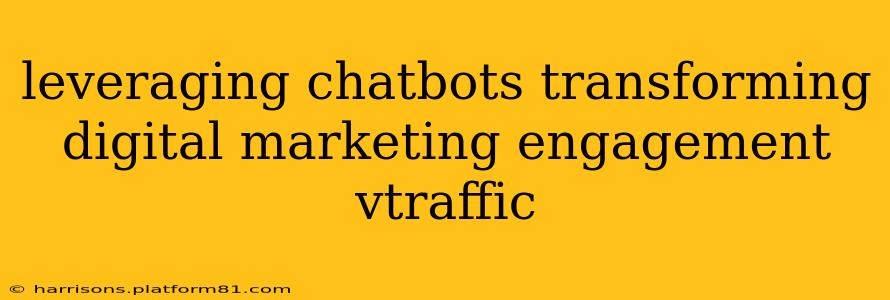The digital marketing landscape is constantly evolving, and staying ahead of the curve requires embracing innovative technologies. One such game-changer is the chatbot. No longer a novelty, chatbots are proving to be powerful tools for enhancing customer engagement and driving significant traffic increases. This article delves into how businesses can leverage chatbots to transform their digital marketing strategies.
What are Chatbots and How Do They Work?
Chatbots are computer programs designed to simulate human conversation. They use artificial intelligence (AI) and natural language processing (NLP) to understand user queries and provide relevant responses. This interaction can happen through various platforms like websites, messaging apps (Facebook Messenger, WhatsApp), and even social media. Sophisticated chatbots can handle complex inquiries, personalize interactions, and even integrate with other business systems like CRM platforms.
How Chatbots Transform Digital Marketing Engagement
Chatbots offer numerous benefits for improving customer engagement:
- 24/7 Availability: Unlike human agents, chatbots are available around the clock, providing immediate assistance and answering questions whenever a customer needs help. This improves customer satisfaction and reduces wait times.
- Personalized Experiences: Chatbots can collect data about individual users, allowing for personalized interactions and targeted recommendations. This tailored approach strengthens customer relationships and boosts conversions.
- Improved Customer Service: Chatbots can handle routine inquiries, freeing up human agents to focus on more complex issues. This leads to faster response times and improved overall customer service quality.
- Lead Generation: Chatbots can qualify leads by asking targeted questions and collecting contact information. This streamlines the sales process and improves lead conversion rates.
- Enhanced Brand Loyalty: By providing helpful and engaging interactions, chatbots help build brand loyalty and create positive customer experiences.
How Chatbots Drive Traffic to Your Website
Beyond enhancing engagement, chatbots can also play a significant role in driving traffic to your website:
- Increased Website Visibility: Chatbots integrated into your website can improve user experience, leading to higher search engine rankings. A better user experience translates into lower bounce rates and longer time spent on site – signals that search engines favor.
- Targeted Advertising: Data collected by chatbots can be used to refine your advertising campaigns, targeting specific demographics and interests. This increases the efficiency of your advertising spend and maximizes your ROI.
- Social Media Marketing: Chatbots can be integrated with social media platforms to engage with potential customers and drive traffic to your website. This allows for quick responses to questions and immediate problem resolution.
- Email Marketing Integration: Integrating chatbot data with email marketing campaigns allows for more personalized and effective email communication, driving traffic back to your website.
What are the different types of chatbots?
There are two primary types of chatbots:
- Rule-based chatbots: These chatbots follow a predefined set of rules and responses. They are simple to implement but lack flexibility and may not handle complex queries effectively.
- AI-powered chatbots: These chatbots use machine learning and natural language processing (NLP) to understand and respond to a wider range of user inputs. They are more sophisticated and can provide more personalized interactions.
What are the best practices for using chatbots in digital marketing?
- Define clear goals: Before implementing a chatbot, clearly define your goals and objectives. What do you want the chatbot to achieve?
- Choose the right platform: Select a platform that aligns with your target audience and business goals.
- Design a user-friendly interface: Make sure the chatbot is easy to use and navigate.
- Test and optimize: Continuously test and optimize your chatbot to improve its performance.
- Integrate with other marketing tools: Integrate your chatbot with other marketing tools to maximize its impact.
How much does it cost to implement a chatbot?
The cost of implementing a chatbot can vary significantly depending on the features and complexity of the chatbot, as well as the platform used. Simple rule-based chatbots can be relatively inexpensive to implement, while more sophisticated AI-powered chatbots can be more costly.
Are chatbots replacing human interaction in marketing?
No, chatbots are not replacing human interaction. Instead, they are augmenting it. Chatbots can handle routine tasks, freeing up human agents to focus on more complex issues and build stronger relationships with customers. The combination of human and AI-driven interactions provides the best customer experience.
By strategically integrating chatbots into your digital marketing strategy, you can significantly improve customer engagement, drive targeted traffic, and ultimately boost your bottom line. Remember that successful chatbot implementation requires careful planning, ongoing optimization, and a focus on providing a valuable and user-friendly experience.
